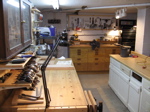Shop-built Router Table Extension Wing
I started out with some red oak cut-offs I had on hand. (Fig. 1) I cut 4 parts to size and clamped them in place to start lining it all out. Once I was happy with how they fit together in the space (Fig. 2), I marked mounting hole locations according to the rails and wing of my table saw. Using these marked holes, I drilled them on my small 9" Delta drill press. (Fig. 3) I made the holes purposely too large so that I could do fine adjustments up and down when I install it. (To line it up flush with my cast iron top and steel wings.)
In Fig. 7, you can see the front of the saw, with the router table frame clamped in place. Things are lining up pretty well. However, the first obstacle pops up here. For construction, I've removed the main rail on which the T2 fence slides. This reveals the countersunk rail holes (Fig. 7) on the front support rail and, in turn, the necessity for any additional bolts (for mounting my router table) not to interfere with the fence sliding up and down the rails. If I tried to use regular hex bolts or lag bolts, the head would stop the fence from sliding. So, I got the idea to simply grind down the heads of the 2 front bolts to make them flat and, hopefully, allow enough clearnce for the fence. It worked! (See Fig. 8 below) Remember, I've only ground the two front bolts I bought for the router table installation, not any of the factory bolts on the rest of my saw, of course.
In Fig. 9, you'll notice that the galvanized bolts I bought for the install are rather long. I wanted to make sure I had plenty of flexibility during the building process. I can always cut them off, but I can't make them bigger and there's nothing I hate more than coming up short in the middle of making good headway on a project, just to run to Lowe's.(Unless, of course, it were closer to my house! ;) ) Fig. 10 shows both front bolts in place. The bolts are rather skinny so they don't interfere with the flush-mounting of the table surface.
In Fig. 9, you'll notice that the galvanized bolts I bought for the install are rather long. I wanted to make sure I had plenty of flexibility during the building process. I can always cut them off, but I can't make them bigger and there's nothing I hate more than coming up short in the middle of making good headway on a project, just to run to Lowe's.(Unless, of course, it were closer to my house! ;) ) Fig. 10 shows both front bolts in place. The bolts are rather skinny so they don't interfere with the flush-mounting of the table surface.
In Fig. 11 and 12, you can see the frame constructed and installed with all 6 bolts. Lookin' good so far. Fig. 13 reveals my next hurdle. Even with the skinny bolts and additional play of the larger holes, the nut still interferes with flushing the melanine into the frame. So, I marked the general area where the nuts meet the melanine with a marker (Fig. 15), turned the top over and routed a freehand hole where they meet. (Fig. 16)
It worked like a champ. (See Fig. 17 and 18) The nuts now fit well into the routed space and allow the top to sit flush with the top of the frame on the top side.
In Fig. 19, I've moved the melanine top to my Workmate and clamped some birch scrap around the area to be router for the plexiglass insert. This is where all the nasty mistakes show up. Despite my best efforts and patience, I forgot to tighten down one clamp and ended up having the router wander on one of the main cuts. (Fig. 20) Nuts. None of the others were perfect, but all in all, its still usable. (Fig. 21 - 23)
In Fig. 19, I've moved the melanine top to my Workmate and clamped some birch scrap around the area to be router for the plexiglass insert. This is where all the nasty mistakes show up. Despite my best efforts and patience, I forgot to tighten down one clamp and ended up having the router wander on one of the main cuts. (Fig. 20) Nuts. None of the others were perfect, but all in all, its still usable. (Fig. 21 - 23)
Fig. 24 above is a shot of the complete routed insert hole and the plexiglass blank shaped to fit it. Next step, boring the holes into the plate for mounting the router.
In Fig. 33, you can see what happens when you get too excited about trying out your new router table and feed the test piece too quickly and too deeply. I broke my 1/4" straight router bit. D'oh! The last one is an underside view of my new PC 9690 all mounted up. Man, I'm psyched. In Fig. 31 and 32 below, you can see the 2 spanning pieces I added for anti-sag support.
Next up, an auxilliary router fence to go over my Delta T2 table saw fence.



































